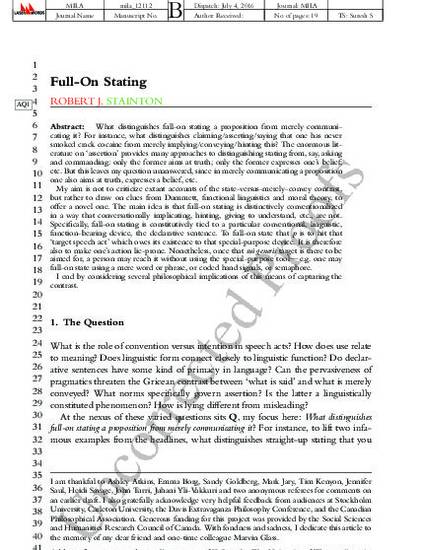
Article
Full-On Stating
Mind and Language
(2016)
Abstract
What distinguishes full-on stating a proposition from merely communicating it? For instance, what distinguishes claiming/asserting/saying that one has never smoked crack cocaine from merely implying/conveying/hinting this? The enormous literature on ‘assertion’ provides many approaches to distinguishing stating from, say, asking and commanding: only the former aims at truth; only the former expresses one’s belief; etc. But this leaves my question unanswered, since in merely communicating a proposition one also aims at truth, expresses a belief, etc.
My aim is not to criticize extant accounts of the state-vs.-merely-convey contrast, but rather to draw on clues from Dummett, functional linguistics and moral theory, to offer a novel one. The main idea is that full-on stating is distinctively conventionalized in a way that conversationally implicating, hinting, giving to understand, etc., are not. Specifically, full-on stating is constitutively tied to a particular conventional, linguistic, function-bearing device, the declarative sentence. To full-on state that p is to hit that ‘target speech act’ which owes its existence to that special-purpose device. It is therefore also to make one’s action lie-prone. Nonetheless, once that sui generis target is there to be aimed for, a person may reach it without using the special-purpose tool – e.g., one may full-on state using a mere word or phrase, or coded hand signals, or semaphore.
I end by considering several philosophical implications of this means of capturing the contrast.
Keywords
- Stating,
- assertion,
- communication,
- non-sentential speech,
- convention,
- Davidson,
- Dummett
Disciplines
Publication Date
September, 2016
Publisher Statement
Uncorrected Proofs. For citation, please consulted the published version
Citation Information
Robert J. Stainton. "Full-On Stating" Mind and Language Vol. 31 Iss. 4 (2016) p. 395 - 413 Available at: http://works.bepress.com/robertstainton/132/
